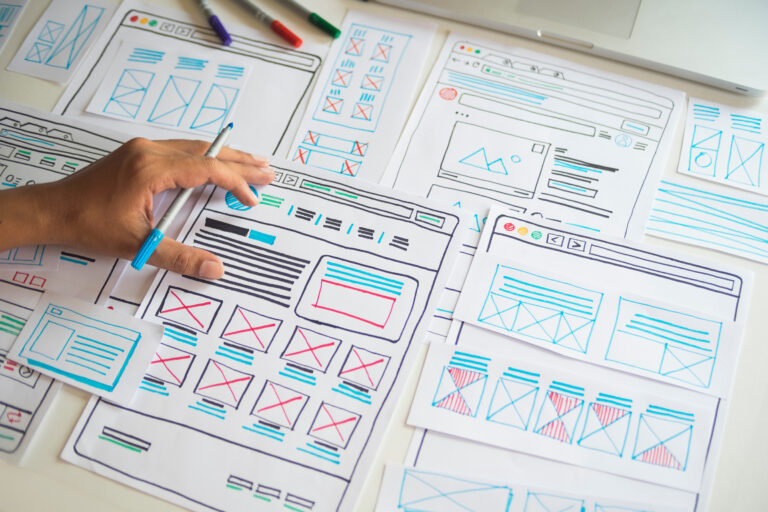Designing for Impact: The Art and Science of E-Commerce Content Design
Published: December 29, 2023 | Content & Design, Tips & Tricks

In the dynamic realm of e-commerce, where the online marketplace is saturated with options, the significance of effective content design cannot be overstated. Designing for impact involves a delicate interplay between the artistry that captures attention and the scientific precision that converts visitors into loyal customers. This article takes a comprehensive look at the multifaceted world of e-commerce content design, exploring both the artistic and scientific dimensions to help businesses create a lasting impression in the digital landscape.
The Art of E-Commerce Content Design
Visual Storytelling: Weaving Narratives with Images
In the visually-driven world of e-commerce, the art of visual storytelling takes center stage. High-quality imagery has the power to convey not just the physical attributes of a product but the emotions and stories associated with it.
- High-Quality Imagery: Professional product photography is an investment that pays dividends. It not only showcases your products in the best light but also conveys a sense of professionalism and quality.
- Lifestyle Imagery: Transport your customers into a world where your products seamlessly integrate into their lives. Lifestyle imagery creates an emotional connection, showing the real-world applications of your offerings.
- Consistent Branding: Your visual identity is your brand’s fingerprint. Consistency in branding, from colors to imagery style, builds recognition and trust. Ensure that every visual element aligns with your brand narrative.
User Interface (UI) and User Experience (UX) Design: Navigating Seamlessly
The user interface and experience are the first touchpoints between your customer and your online store. A well-designed UI/UX enhances user satisfaction and fosters a positive perception of your brand.
- Intuitive Navigation: Design your website structure with the end-user in mind. Clear menus, logical categorization, and a straightforward navigation flow make it easy for visitors to find what they’re looking for.
- Mobile Responsiveness: With a surge in mobile commerce, ensuring your website is seamlessly responsive on various devices is not just a nicety but a necessity. A positive mobile experience can be a game-changer for your business.
- Streamlined Checkout Process: A complicated checkout process is a major deterrent. Simplify and streamline the journey from cart to completion, minimizing friction and reducing the likelihood of abandoned carts.
Story-Driven Product Descriptions: Beyond Features to Emotions
Transforming product descriptions into engaging narratives elevates your e-commerce content from a mere list of features to a compelling story that resonates with your audience.
- Focus on Benefits: Highlight the value your product brings to the customer. Instead of merely listing features, explain how those features enhance the customer’s life or address a specific need.
- Use Persuasive Language: Crafting product descriptions is an art in itself. Use language that taps into the emotions of your audience, persuading them to visualize the positive impact your product can have on their lives.
- SEO-Optimized Descriptions: While storytelling is crucial, don’t neglect the SEO aspect. Integrate relevant keywords seamlessly, ensuring that your product descriptions are not only compelling but also discoverable by search engines.
The Science of E-Commerce Content Design
Data-Driven Decision Making: Unveiling Insights
The scientific facet of e-commerce content design involves utilizing data to gain insights into user behavior, preferences, and areas of improvement.
- Analytics Tools: Deploy robust analytics tools to track user behavior on your website. Understand which pages are popular, where visitors drop off, and what products are frequently viewed or abandoned in carts.
- A/B Testing: Experimentation is key. A/B testing involves presenting two versions of a web page to users and analyzing which performs better. This data-driven approach helps in refining and optimizing your design continually.
- Personalization: Leverage data to personalize the user experience. From personalized product recommendations to tailored content, customization based on user preferences enhances engagement and conversion rates.
Search Engine Optimization (SEO): Navigating the Digital Landscape
In a world where search engines act as gatekeepers to online content, optimizing your e-commerce platform for searchability is paramount.
- Keyword Research: Dive deep into keyword research. Understand the terms and phrases your target audience is using to search for products similar to yours. Integrating these keywords naturally into your content boosts your visibility on search engines.
- Meta Tags and Descriptions: Pay attention to meta tags and descriptions. These are the snippets that appear on search engine result pages. Crafting compelling and informative meta content not only improves click-through rates but also positively influences your search rankings.
- Content Freshness: Regularly update your content. Search engines favor fresh and relevant content. Whether it’s updating product descriptions, publishing blog posts, or refreshing landing page content, consistent updates signal to search engines that your website is active and relevant.
Conversion Rate Optimization (CRO): Turning Visitors into Customers
The ultimate goal of e-commerce content design is not just to attract visitors but to convert them into paying customers. Conversion rate optimization (CRO) focuses on refining your website to achieve this objective.
- Call-to-Action (CTA) Buttons: Strategically place clear and compelling CTAs throughout your website. Whether it’s a “Buy Now” button or a newsletter sign-up prompt, the language and placement of CTAs can significantly impact conversion rates.
- Social Proof: Showcase customer reviews and testimonials prominently. Positive reviews build trust and credibility, addressing potential concerns that prospective customers may have.
- Loading Speed Optimization: In the fast-paced digital world, speed matters. Optimize your website’s loading speed to prevent potential customers from bouncing. Slow-loading websites not only frustrate users but can also negatively impact your search engine rankings.
Connecting the Art and Science
The true magic of e-commerce content design lies in the seamless integration of artistic elements with data-driven insights. It’s not about choosing between aesthetics and analytics but finding the delicate balance that maximizes impact.
- Aesthetic Consistency with Data-Backed Iterations: While maintaining a visually appealing website is crucial, regularly iterate based on data-driven insights. If certain visual elements aren’t resonating with your audience, be prepared to adapt.
- Emotional Appeal Supported by Analytics: Use analytics to understand the emotional triggers that drive conversions. While emotions influence purchasing decisions, backing these emotional appeals with analytics ensures that your design choices are rooted in tangible data.
- Adaptability to Trends with a Foundation in User Behavior: Stay attuned to design trends, but prioritize elements that align with your audience’s preferences and behaviors. A trendy website is good, but a website that understands and resonates with its users is unbeatable.
Conclusion: Crafting a Lasting Impression
In the ever-evolving landscape of e-commerce, designing for impact requires a holistic approach that embraces both the art and science of content creation. By seamlessly integrating visually captivating elements with data-driven precision, businesses can create a digital presence that not only captivates but converts.
Ready to elevate your e-commerce content design? Connect with geekspeak Commerce to learn more about how we can optimize your online store for impact.







